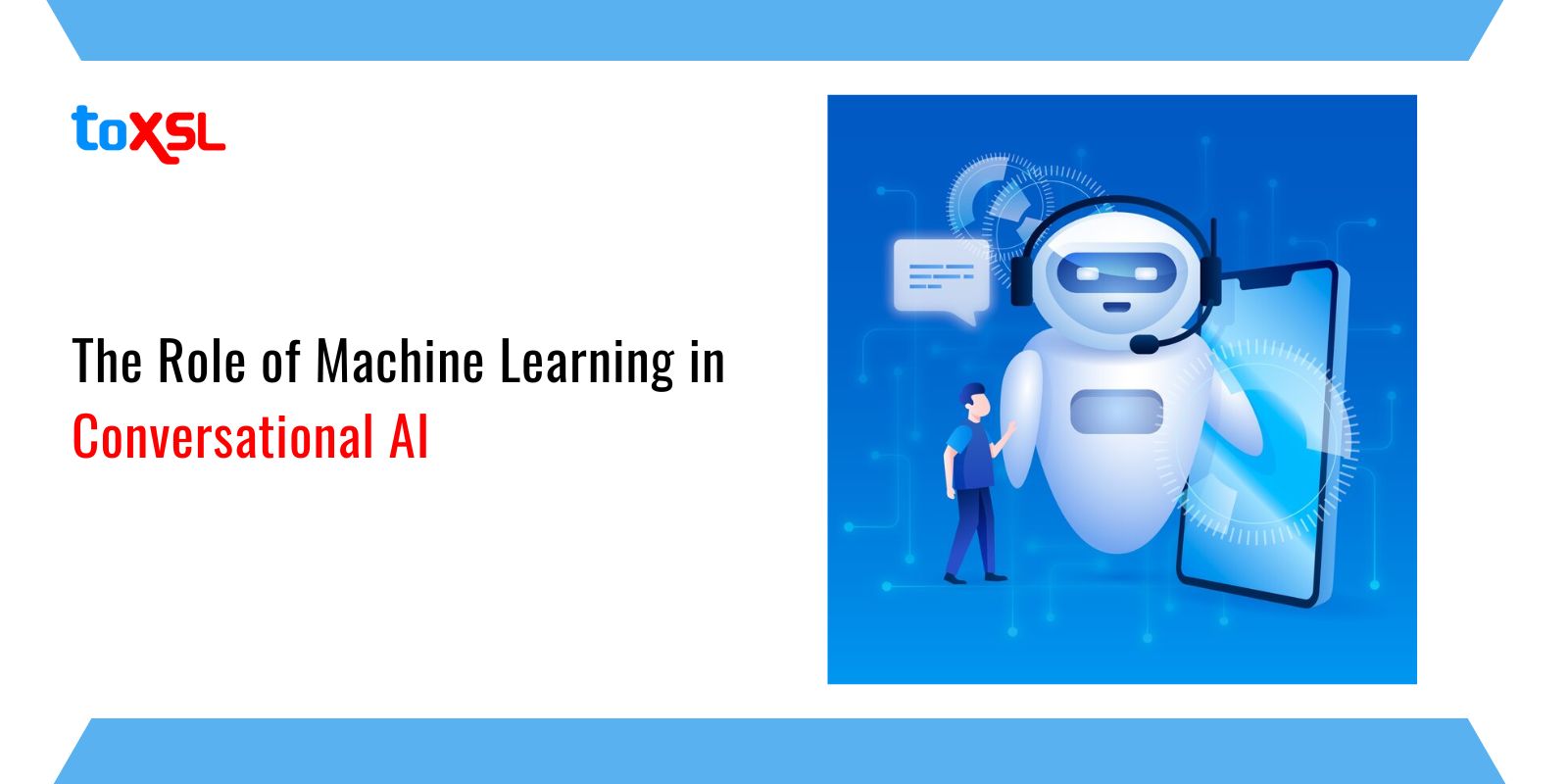Every day, we're getting closer to a world where chatbots communicate and virtual assistants predict needs. As our lives become more connected to the digital world, we're focusing on how conversational AI is changing everything. Artificial intelligence is a big part of our daily lives, so it's important to understand how businesses can use conversational AI to improve customer service.
97% of executives say that conversational AI has positively impacted their business. Companies have benefited in terms of Conversational AI has helped them enhance productivity and helped them fix customer issues as fast as possible.
In this guide, we'lldive into conversational AI, a technology that's changing businesses and making us wonder who's writing the words we read.
Fundamental Conversational AI Trends
In this section, we will discuss a few fundamental conversational AI trends:
- Proactive Conversations: Conversational AI is shifting towards proactive conversations, where systems provoke interactions primarily based totally on predictive analytics and contextual understanding, enabling them to address user needs before they arise. This proactive approach not only enhances user experience by providing timely assistance but also allows organizations to expect and resolve ability issues before they escalate into main problems.
- Multimodal and Multichannel Conversations: Conversational AI is evolving to handle multimodal inputs consisting of text, voice, images, videos, and gestures, whilst additionally presenting seamless interactions throughout a couple of channels like email, social media, SMS, and websites. This functionality guarantees that customers can interaction with AI systems of their preferred mode, whether or not it`s through voice instructions on smart speakers or text-based queries on messaging apps, and continue conversations without interruption across one-of-a-kind platforms.
- Advanced Continuous Training: AI systems are adopting self-learning mechanisms to refine their capabilities autonomously through real-time learning and dealing with complex language nuances without manual intervention. By continuously analyzing live customer interactions, those systems can enhance accuracy and relevance, lowering the need for human oversight at the same time as enhancing their ability to manage complex queries with empathy and precision.
- Hyper-Personalization: Conversational AI is leveraging historical data and real-time analytics to create hyper-personalized experiences by understanding individual preferences and adapting interactions dynamically. This personalization allows AI systems to tailor recommendations, tone, and content material to match the unique needs and alternatives of every user, thereby strengthening consumer relationships and fostering loyalty by making interactions feel unique and meaningful.
- Voice-driven Conversational AI: Voice interfaces are becoming increasingly popular due to improvements in speech recognition and noise management technologies, improving accessibility, and general speech translation capabilities. Voice-driven AI is especially impactful for enhancing user experience in smart home devices and IoT systems, where users can control appliances or access data through easy voice commands, and it additionally serves as a crucial device for older populations and differently abled individuals who may also conflict with text-based interfaces.
- AI Integration: Conversational AI is being integrated with other emerging technologies such as generative AI, blockchain, AR/VR, and IoT to expand its applications across diverse domains. This integration enables businesses to innovate beyond traditional customer service roles, creating immersive experiences in virtual environments, enhancing data security with blockchain, and automating complex tasks with IoT, thereby unlocking new possibilities for interaction and engagement.
- Customer Interaction: Conversational AI is revolutionizing customer interaction by providing faster resolutions, deeper engagement, empathy-driven conversations, and the capacity to address complicated transactions directly within chat interfaces. By knowing feelings and responding empathetically, AI structures can address customer concerns more effectively, reducing frustration and enhancing average satisfaction. Additionally, the capacity to method transactions and manage accounts within the chat itself streamline customer service, making it more efficient and user-friendly.
Machine Learning to the Rescue: A Paradigm Shift
Machine Learning offered a fundamentally different approach. Instead of explicitly programming responses, ML algorithms learn patterns from vast amounts of data (text, voice recordings, conversations). This data, known as the training data, allows the AI to "learn" how humans communicate. The real power lies in its ability to generalize – to understand and respond to inputs it hasn't explicitly seen before. Let’s break down the key ML techniques driving Conversational AI:
1. Natural Language Understanding (NLU): Deciphering Intent
NLU is the cornerstone of Conversational AI. It's the process of taking user input (text or voice) and extracting meaning from it. This involves several sub-tasks:
- Intent Recognition: Determining what the user wants to achieve. For example, in "Book me a flight to London," the intent is "book_flight."
- Entity Extraction: Identifying key pieces of information required to fulfill the intent. In the same example, "London" is the entity (the destination).
- Sentiment Analysis: Gauging the user's emotional state (positive, negative, neutral). This allows the AI to tailor its responses appropriately.
- Disambiguation: Resolving ambiguity in language. For instance, understanding whether "book" refers to a flight or a physical book.
Common ML Models for NLU:
- Recurrent Neural Networks (RNNs) & Long Short-Term Memory (LSTM): These were early workhorses for processing sequential data like text. They excel at remembering the context of previous words in a sentence.
- Transformers (e.g., BERT, RoBERTa): These architectures have revolutionized NLU. They use a “self-attention” mechanism to understand the relationships between words in a sentence, leading to vastly improved accuracy. BERT, in particular, is pre-trained on massive datasets and can be fine-tuned for specific NLU tasks.
- Zero-shot and Few-shot Learning: Emerging techniques that allow models to understand intents and entities with little or no training data.
2. Dialogue Management: Orchestrating the Conversation
Once the NLU component understands what the user wants, the Dialogue Management (DM) system takes over. Its role is to:
- Track the Conversation State: Remember what's been said and what information is still needed.
- Decide the Next Action: Determine whether to ask a clarifying question, retrieve information, execute a task, or end the conversation.
- Generate the Response: Craft a natural-sounding reply.
Approaches to Dialogue Management:
- Finite State Machines (FSMs): Simple, but inflexible for complex dialogues.
- Rule-Based Dialogue Management: More sophisticated than FSMs, but still limited by pre-defined rules.
- Reinforcement Learning (RL): An exciting area where the AI learns through trial and error, optimizing the conversation flow to maximize user satisfaction.
- End-to-End Dialogue Models: These models, often based on Transformers, attempt to handle NLU and DM simultaneously, simplifying the architecture.
3. Natural Language Generation (NLG): Crafting Human-Like Responses
NLG is the final stage, responsible for transforming the AI's internal representation of the response into a natural-sounding text.
Common ML Models for NLG:
- Template-Based NLG: Uses pre-defined templates with slots that are filled in with relevant information. Simple to implement, but limited in expressiveness.
- Statistical NLG: Uses probabilistic models to generate text based on training data.
- Neural NLG: Utilizes deep learning models (e.g., Transformers like GPT-3) to generate fluent and contextually relevant responses. These models can produce surprisingly human-like text but require significant training data.
The Future of Customer Interaction is Conversational. Are You Ready?
Conversational AI is unexpectedly evolving, and the developments outlined in this post represent just the beginning of what's possible. Businesses that embrace these trends and put money into conversational AI answers may be well-placed to supply splendid client experiences, power efficiency, and gain a competitive advantage.
Conclusion:
As we look at how conversational AI helps customer interactions, one thing is clear, conversational AI is not just a tool but a way to improve customer happiness and make businesses run more smoothly.
Conversational AI has the power to change industries and make user experiences better. It's leading the way in new technology. As we move into the future, this technology will keep growing and changing, making interactions feel more like talking to a person and giving personalized answers. This change is something businesses should welcome to stay ahead and give customers amazing experiences.
ToXSL Technologies is a leading Artificial Intelligence services provider company. Our AI developers ensure to deliver the best solution as per your business need. Contact us and leverage our AI services today.
FAQs
1. What is the role of Machine Learning in Conversational AI?
Machine Learning enables Conversational AI systems to learn from interactions, improving their ability to understand and respond to user queries. By analyzing data patterns, ML models enhance accuracy, context-awareness, and personalization, allowing virtual assistants and chatbots to engage in more human-like, intelligent conversations, ultimately improving user experience over time.
2. How does Machine Learning improve chatbot responses?
Machine Learning helps chatbots by enabling them to learn from past conversations, recognize patterns, and predict user intent. With continuous training, ML models refine responses based on context, allowing chatbots to offer more relevant, accurate, and personalized answers. This leads to improved user satisfaction and a more seamless conversational experience.
3. What challenges does Machine Learning face in Conversational AI?
Machine Learning in Conversational AI faces challenges like understanding nuanced human language, dealing with ambiguous context, and ensuring diverse language support. Poor data quality or biased training data can lead to inaccurate or biased responses. Additionally, developing AI that can handle complex, multi-turn conversations remains an ongoing challenge for researchers and developers.
4. What does the future hold for Machine Learning in Conversational AI?
The future of ML in Conversational AI includes advancements in Natural Language Processing (NLP) for more natural, context-aware interactions. AI will better understand emotions, handle multilingual dialogues, and improve decision-making. As these technologies evolve, we can expect more intelligent, efficient, and empathetic AI systems in customer service, healthcare, and other industries.

















Share this post on: